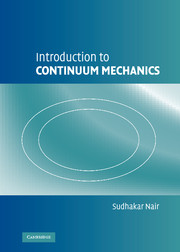Book contents
- Frontmatter
- Contents
- Preface
- Introduction to Continuum Mechanics
- 1 Introduction
- 2 Cartesian Tensors
- 3 General Tensors
- 4 Integral Theorems
- 5 Deformation
- 6 Motion
- 7 Fundamental Laws of Mechanics
- 8 Stress Tensor
- 9 Energy and Entropy Constraints
- 10 Constitutive Relations
- 11 Hyperelastic Materials
- 12 Fluid Dynamics
- 13 Viscoelasticity
- 14 Plasticity
- Author Index
- Subject Index
3 - General Tensors
Published online by Cambridge University Press: 05 June 2012
- Frontmatter
- Contents
- Preface
- Introduction to Continuum Mechanics
- 1 Introduction
- 2 Cartesian Tensors
- 3 General Tensors
- 4 Integral Theorems
- 5 Deformation
- 6 Motion
- 7 Fundamental Laws of Mechanics
- 8 Stress Tensor
- 9 Energy and Entropy Constraints
- 10 Constitutive Relations
- 11 Hyperelastic Materials
- 12 Fluid Dynamics
- 13 Viscoelasticity
- 14 Plasticity
- Author Index
- Subject Index
Summary
There are a number of continuum mechanics books in the literature, written with the general tensor formulation. An essential characteristic of general tensors is the use of curvilinear coordinates. We may imagine a Cartesian grid placed inside a continuum. As the continuum deforms, the grid lines deform with it into a mesh of curves. Thus general tensor formulations are convenient to describe continuum mechanics. Although this chapter is not required to follow our presentation of continuum mechanics in terms of Cartesian tensors, it will be of value to extend the students' knowledge through additional reading. In modern computational mechanics, curvilinear grids are often used and the governing equations in general tensor formulation are needed. As an added bonus, students will be able to follow the theory of shells and the general theory of relativity!
In the previous chapter we saw systems of Cartesian coordinates and transformations of tensors between two coordinates that are related linearly. When we have to deal with curvilinear coordinates, the coordinate transformations are in general nonlinear and the coordinates may not form an orthogonal system. Representation of tensors in such a system depends on the directions of local tangents and normals to the coordinate surfaces. It is conventional to use superscripts to denote the coordinate curves. The reason for this will be clarified later. Let us begin with a Cartesian system with labels x1, x2, and x3, transforming into curvilinear system ξ1, ξ2, and ξ3.
- Type
- Chapter
- Information
- Introduction to Continuum Mechanics , pp. 27 - 41Publisher: Cambridge University PressPrint publication year: 2009



